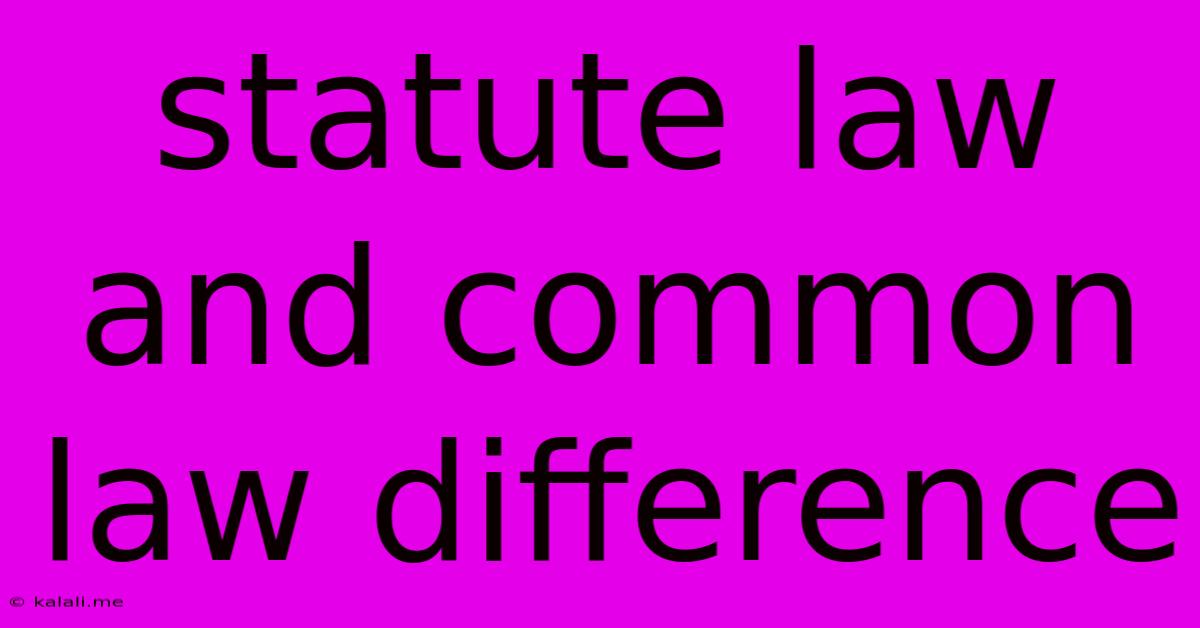Statute Law And Common Law Difference
Kalali
Jun 11, 2025 · 3 min read

Table of Contents
Statute Law vs. Common Law: Understanding the Key Differences
This article explores the fundamental differences between statute law and common law, two crucial pillars of many legal systems worldwide. Understanding their distinctions is essential for anyone navigating legal matters, whether as a professional or a citizen. We'll delve into their origins, creation processes, and practical implications.
Meta Description: Learn the core differences between statute law (legislation passed by Parliament) and common law (judge-made law based on precedent). This guide clarifies their origins, creation, and practical applications.
What is Statute Law?
Statute law, also known as statutory law or legislation, is the law created by a legislative body, such as a parliament or congress. These laws are formally written and enacted through a specific legislative process, which typically involves drafting, debating, and voting. Once passed and signed into law, statutes become binding on everyone within the jurisdiction. Examples include laws relating to taxation, criminal offenses, and environmental protection. Statute law is characterized by its:
- Formal Written Form: It's codified and readily accessible.
- Explicit Authority: It's created by a body explicitly given the power to make law.
- Prospective Effect: It generally applies to future actions, not past ones (except in cases of ex post facto laws, which are generally prohibited).
- Supremacy: Generally, statute law overrides conflicting common law.
What is Common Law?
Common law, also known as case law or judge-made law, originates from judicial decisions rather than legislative bodies. It's based on the principle of stare decisis, which means "to stand by things decided." Judges interpret and apply existing laws to specific cases, and their decisions create precedents that future courts must follow in similar situations. This creates a body of legal principles developed through judicial rulings over time. Key characteristics include:
- Judicial Precedent: Decisions in past cases guide future rulings.
- Evolutionary Nature: It develops gradually, adapting to societal changes and evolving interpretations.
- Flexibility: While bound by precedent, judges have some room for interpretation and adaptation.
- Inferential Nature: It is not explicitly written in a code, but inferred from judicial decisions.
Key Differences Summarized
| Feature | Statute Law | Common Law |
|---|---|---|
| Source | Legislative body (Parliament, Congress) | Courts and judicial decisions |
| Form | Written and codified | Developed through case precedents |
| Creation | Formal legislative process | Judicial interpretation and application of law |
| Effect | Generally prospective | Retrospective in some cases (precedent setting) |
| Flexibility | Less flexible; requires amendment to change | More flexible; adapts through judicial rulings |
| Specificity | Generally more specific and detailed | Can be more broad and open to interpretation |
Interaction Between Statute and Common Law
Statute and common law are not mutually exclusive; they interact and complement each other. Statutes often codify existing common law principles, providing greater clarity and certainty. Conversely, courts often interpret and apply statutes, clarifying their meaning and resolving ambiguities. The relationship between the two is dynamic and constantly evolving.
Conclusion
Understanding the distinction between statute law and common law is crucial for comprehending the legal landscape. While both are vital sources of law, their origins, creation processes, and characteristics differ significantly. This knowledge is essential for anyone seeking a deeper understanding of legal principles and their practical applications. By grasping these fundamental differences, individuals can better navigate the complexities of the legal world and effectively engage with the law.
Latest Posts
Latest Posts
-
How Long Was Steven Leslie Sentenced To Imprisonment
Jul 01, 2025
-
How Many Quarts Is In 64 Ounces
Jul 01, 2025
-
What Is 1 And 1 4 Cup In Half
Jul 01, 2025
-
How Many Chicken Drumettes In A Pound
Jul 01, 2025
-
How Much Is A Quarter Million Dollars
Jul 01, 2025
Related Post
Thank you for visiting our website which covers about Statute Law And Common Law Difference . We hope the information provided has been useful to you. Feel free to contact us if you have any questions or need further assistance. See you next time and don't miss to bookmark.